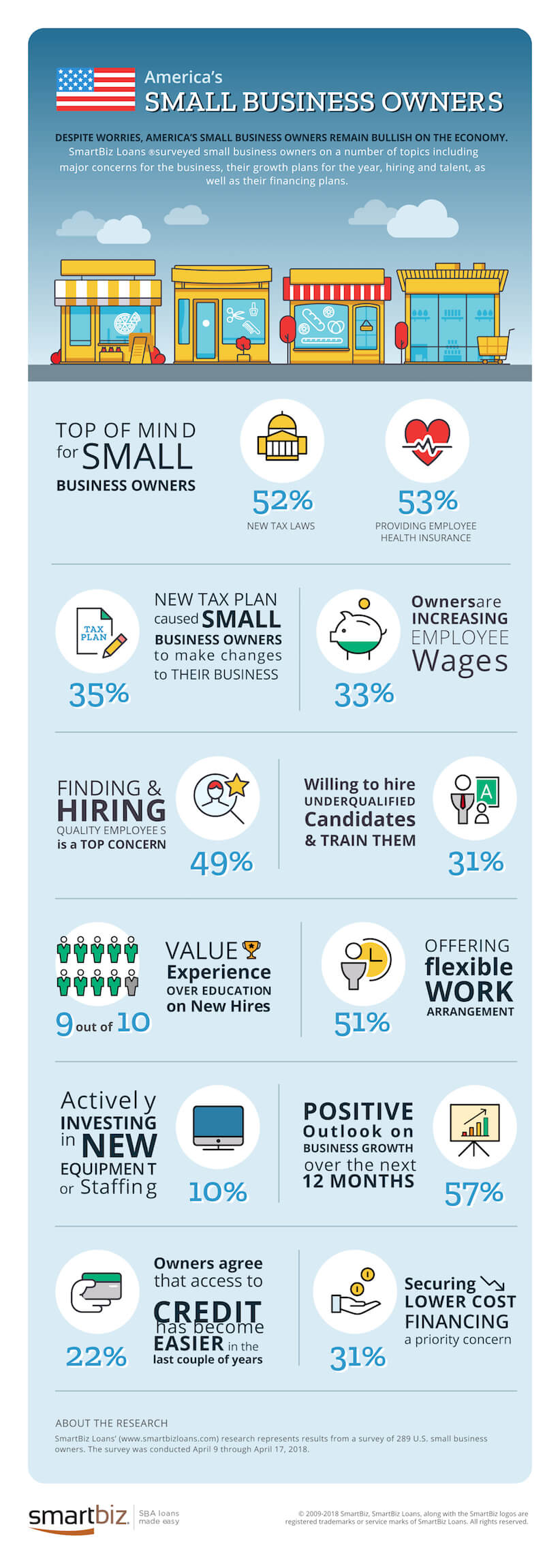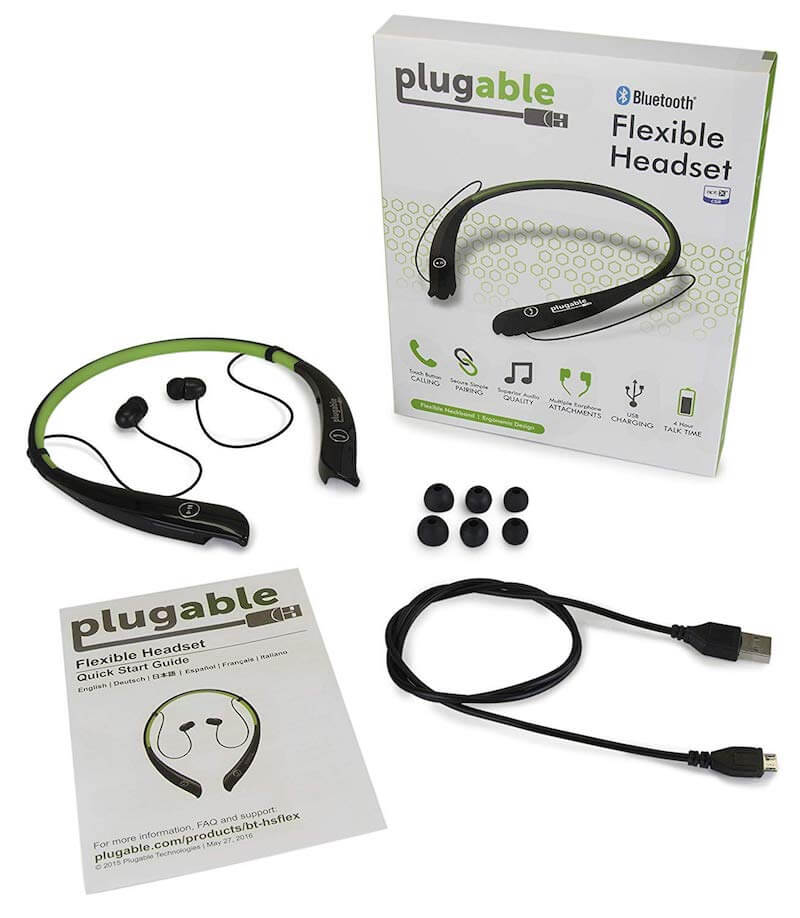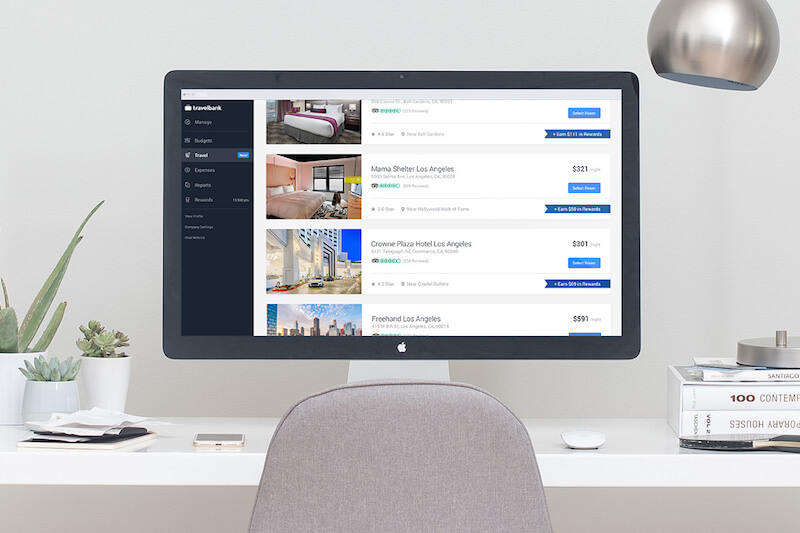16 Things Small Business Owners Need to Know
1—What Small Business Owners are Thinking
What’s top of mind for American’s small business owners? Check out the infographic below from SmartBiz Loans to find out.

2—The Secret Life of Websites
SiteLock just finished its Q1 report on website security trends, and the news isn’t good. In Q1, websites saw a 14% increase in attacks from Q4, with the average site being hit 50 times a day. Some other interesting findings include:
- 24% of website owners surveyed experienced damage to their business’s reputation as a result of a website security incident
- As many as 7 million websites are infected with malware at any given moment
- Bad bots made up 88% of traffic filtered by firewalls
Read the report—it’s well worth your time.
3—Optimizing Remote Work
One of the best things about being a small business owner these days is it’s possible and often preferable to work at home. And working remotely is not just for solopreneurs either.
According to Remote.co, remote work has increased 115% since 2005 and it is predicted that 38% of full-time staff will be working remotely in the next decade. To offer insight into how and why remote work is an effective business strategy for a growing number of companies and teams, Remote.co has compiled feedback from 137 companies regarding common questions and answers on how to manage and operate effectively within a remote workplace environment.
“Forward-thinking companies are embracing remote work as a viable, modern business model that increases employee productivity, saves money, and broadens access to talent in a tight labor market,” says Sara Sutton Fell, Founder and CEO of Remote.co and FlexJobs. She adds, “Having run a fully distributed company for more than 11 years, I know first-hand that there are critical strategies and management techniques necessary to make remote work a success, whether it’s applied to one worker, a team, or an entire business. If done correctly and intentionally, remote work can be incredibly beneficial to the company’s success, bottom line, workers, and community.”
Here are some of the insights:
Big picture of remote work
Overview: Nearly 3% of the total U.S. workforce work from home at least half of the time. The average telecommuter is 46 years or older, has at least a bachelor’s degree, and earns a higher median salary than an in-office worker. Remote work is available across career levels and industries (top four are healthcare, computer/IT, education, sales).
Challenges: Preventing employee isolation and overwork; creating a healthy company culture; communication; coordinating across time zones; tracking worker accountability; managing legal/tax issues.
Benefits: Increased worker productivity and efficiency; higher employee morale; reduced employee turnover; real estate and overhead savings; access to a greater, more diverse talent pool; happier, healthier, and more engaged employees; avoiding disruptions in workflow (from weather, etc.); better social and environmental stewards.
Tips for working remotely
Traits of effective remote employees: Self-starter; self-motivated; independent; proactive; self-aware; mature; strong written and verbal communication skills; time management skills; previous remote work experience; professionalism; tech savvy; observant; goal-oriented.
Collaboration/communication tools: Slack, Skype, Google Chat, Trello, Pivotal Tracker, Basecamp, Yammer, Hangouts, Skype, Zoom.us, GoToMeeting, join.me.
How to avoid distractions: Secure a dedicated work space in your home; incorporate breaks and exercise into your day; shut down social media; avoid meetings during your most productive hours; use noise-canceling headphones
Tips for managing remotely
Measuring productivity: Productivity is typically measured the same way in a virtual environment as it’s measured in an office: results, output, quality of work, manager feedback, and customer satisfaction.
Building relationships: Create a culture of trust and transparency; establish communication norms (for both synchronous and asynchronous needs); hold regularly scheduled meetings; have an instant “virtual office space;” annual face-to-face retreats; give real-time feedback; establish clear expectations and deliverables, use the right technology.
Creating company culture: Throw virtual parties and events; create virtual watercooler opportunities (like lunch hangouts, coffee breaks, books clubs); assign a buddy or mentor to new hires; embrace work flexibility; celebrate anniversaries, birthdays, holidays, and milestones; highlight individual volunteer and humanitarian efforts.
4—Keeping Your Employees Safe
Drones apparently are more than a toy. According to Nationwide’s annual Business Owners Study of 1,000+ small and mid-sized business owners, small businesses are relying on connected tech for a key concern: keeping their employees safe.
Almost one-third of small business owners rely on technologies like telematics, drones, wearables and building sensors to support their workplace safety. Millennials are leading the charge with a 71% adoption rate. These connected technologies are making small and mid-sized businesses across the U.S. safer places to work.
Yet, though these companies’ safety efforts get smarter through connected tech, nearly half of small and mid-sized business owners still struggle with the basics of workplace safety:
- 51% do not employ a dedicated safety professional.
- 38% do not offer formal safety training.
- 51% do not have a contingency or succession plan in place.
Here’s a deeper dive on business owners’ use of connected technologies for safety efforts:
In all, 32% and 71% of millennial business owners use connected technology for safety efforts.
- Building sensors are used by 16% of all business owners and 36% of millennial business owners to detect humidity, temperature, water leaks and equipment failure.
- Wearables like watches, belts and personal sensors are used by 13% of all business owners and 32% of millennial business owners to detect physical strain of employees.
- Dronesare used by 7% of all business owners and 21% of millennial business owners to reach or inspect areas that could be dangerous for workers.
- Vehicle telematics solutionsare used by 11% of all business owners and 20% of millennial business owners to help r)educe employees’ distracted driving.
5—Is the U.S. Review Obsessed?
An interesting survey from OneSEOCompany indicates we are. The survey shows 66% of Americans have a Yelp addiction. They find new products and services by searching for them directly (via Yelp and Google reviews).
Other insights:
- 64% of reviews are misleading
- 64% of Americans say having an awesome experience prompts them to leave a review.
- 44% say they’ll leave a horrible review after a bad experience
- Internet indecision paralyzes 38% of Americans: they spend more than 15 minutes searching for new products and services before deciding what to buy.
America’s 10 most review-obsessed states (based on the percentage of Americans who primarily Yelp or Google to find businesses)
- Kentucky (77%)
- Washington (76%)
- Louisiana (75%)
- Oklahoma (75%)
- Oregon (75%)
- Pennsylvania (75%)
- California (73%)
- Texas (71%)
- Missouri (70%)
- Georgia (68%)
6—“Summer Camp” for Entrepreneurs
Daniel Levine and Steven Pulver had a dream. They were “tired of conferences” and dreamed of making an “unforgettable growth experience for entrepreneurs, like a summer camp.” (Coincidentally, they then discovered they grew up going to the same summer camp.)
From this “shared vision to create an off-the-grid retreat featuring the brightest minds in business, venture capital and media,” Fireside Conference was born. Fireside, an invite-only event, “blends adventure and mindfulness activities and topics range from VR, cannabis business, startup growth, to cryptocurrency and more.” This year guests will be joined by, among others, internet entrepreneur Jason Calacanis and Jordan Harbinger, cofounder of the podcast The Art of Charm.
Fireside takes place September 6-9 (about three hours outside of Toronto, Canada), coincidentally at the very same lake Dan & Steve camped by as kids.
and “combines camp activities like canoe/kayak, waterski, and rock climbing with mindfulness, yoga and fitness boot camps. Plus, there’s conference sessions, panels, workshops and mastermind talks with brilliant leaders in our community.”
There are about 50 spots available for application. You can apply at apply.firesideconf.com. Or visit their FiresideConf to apply. Or check out the Guide to Fireside video.
7—Pen and Paper is Still The Best Way to Take Notes
Online personalized notebook retailer My Own Stationery conducted a survey to find out whether people prefer using the traditional notebook and pen to take notes in meetings and lectures, or using an electronic device.
The results:
- 4% favor taking notes on paper
- 3% of those who understood “most” to “all” of those notes later
- 6% prefer digital devices
- 85% of digital note takers understood “most” to “all” of those notes later. But 15% of those could only understand “some” of their notes upon reflection.
Why do people take notes digitally?
- 30% say typing is easier or faster than handwriting
- 25% say it’s easier to read and search their notes later
- 20% needed to access their computer or tablet for other reasons during note taking
Why do people take notes by hand?
- 2% says it’s easier to handwrite their notes
- 2% felt they could engage better with the content
- 7% remembered their notes better when writing them
- 9% prefer notebooks so they can draw diagrams alongside their notes
- 4% prefer paper because it’s quieter than a keyboard
8—7 Steps to “Attracting” Success
Guest post by James Whittaker, author of Think and Grow Rich: The Legacy, and executive producer of the Think and Grow Rich movie.
- Get clear on what you want.Ending up at your destination is impossible unless you know where you’re going. Fill out a goals sheet and then share it with the people closest to you, maybe a spouse, parent or friend, so they know how serious you are about your future and can support you. Then, at the start of each day, think about what action you will take that will inch you closer to your goals. Before you go to bed, review the success of your day and calibrate accordingly. You are the only one who is responsible for your future, so commit to a timeframe and stick to it—no matter what.
- Pay yourself first.From every paycheck, make sure a portion is set aside for your own future. For even better results, make the process automatic. Talk to your bank about having a portion of your paycheck transferred to an account you cannot withdraw from. An alternative is to use one of the many mobile apps that can not only save money but allocate it to an investment in line with your age, income and risk profile. Paying yourself first not only keeps you success-focused, it enables you to achieve your goals quickly, efficiently and consistently.
- Spend less than you earn. Comedian Will Rogers once said, “Too many people spend money they haven’t earned to buy things they don’t want to impress people they don’t like.” If you don’t know where all your money is going, comb through recent bank statements and get into the habit of using a household budget. Where possible, eliminate your reliance on credit cards, gradually pay down bad debt, and start to free up unnecessary expenditures.
- Focus on consistency, not complexity.The key to long term success is to aim for small wins consistently. Over time, these add up—to a lot. Look up a compound interest chart to see just how powerful this can be. Most people take massive action, before finding out they were too ambitious and quickly slip back into their old ways. When you’re trying to master your money, developing the habit is far more important than the dollar value—there’ll be plenty of time for loftier goals down the track. As the Brits say, “Look after the pennies and the pounds will look after themselves.”
- Surround yourself with winners.As with any goal, your environment should support your daily actions rather than tempting you into failure. If your goal is to lose weight, it would be futile having gallons of soda and junk food in your cupboards. Surround yourself with people who believe in you, who support your goals, or who have already achieved the success you want so you can learn from their example. While it can be difficult to end a toxic relationship, friendship or get out of your comfort zone to start a new one, you’ll be far better off in the long run if you know what you want and pay the daily price—the hard work and sacrifice—to bring it to life.
- Enjoy the process.With anything worthwhile, adversity is guaranteed. Congratulate yourself for making the decision to change your life and to positively influence those around you. When times get tough, remember it’s just an opportunity to prove how badly you want it. Embrace the struggle and persist until you hit your goal.
- Start now.Winners take action. Stop procrastinating and start now!
9—Amazon Prime Day Deals
Today is Amazon Prime Day—one filled with great deals on the site. Here are two you might otherwise overlook:
The Plugable Digital Microscope is useful and fun for students, collectors, testers, and anyone interested in exploring the microscopic world. The Microscope features LED halo light with brightness adjustment and works with Windows and OS X. The Microscope will be available on Prime Day for $27.00.
The Plugable Bluetooth Headset (below) is a great solution for active individuals who spend much of their time involved in activities. The Bluetooth Headset includes neckband, In-Ear, and Built-in Mic for comfort and tech accessibility during exercise or errands, and will be available during Prime Week for $15.32.

10—Online Valuations of Small Businesses
TD Bank and BizEquity have joined forces. TD Bank is offering its SMB customers a fast and no-cost comprehensive business valuation from BizEquity, an online business valuation tool that provides fair market, enterprise and liquidation values calculated in real time and based on current market factors. This service typically costs several thousand dollars, but it’s free for TD Bank’s SMB customers. BizEquity delivers a detailed report with valuation information and key industry performance indicators to TD Bank relationship managers, who then share it with the business owner.
The benchmarks and financial insights provided through the BizEquity report can assist business owners as they develop strategic and succession plans; analyze funding and acquisition opportunities; and create tax planning options.
Quick Takes
11—Consequences of a Trade War
Read this great post from Experian about the possible fallout on your finances from the recently imposed tariffs and a potential trade war.
12—Raising Money for Minority Business Owners
If you’re a minority business owner, check out this excellent guide from Bankrate about how to raise money.
13—Get a Better Night’s Sleep
In a case of “do as I say and not as I do,” here are two interesting posts about getting more sleep and being mindful so you can lead a “balanced life” from Nestmaven.
Cool Tools
14—IT Solutions for Businesses with Multiple Locations
Verizon Business Markets recently launched its Software Defined Secure Branch solution for businesses with multiple locations, state and local governments, and educational institutions.
According to Verizon Business Markets, “Software Defined Secure Branch is designed for businesses and organizations with complex IT management needs and the desire for more visibility, security protection, and control of their network. Once in place, it keeps the network secure and accessible through a combination of simplified management, the intuitive software defined wide area network (SD-WAN) solution, and security.”
“Software Defined Secure Branch lets our customers focus on their business or organization as first priority, leaving the IT to us,” says Victoria Lonker, Verizon’s vice president of global products and solutions. “The simple, intuitive experience delivers rapid provisioning, a mobile management app, service health, application visibility and the security controls needed to protect the business.”
Software Defined Secure Branch, offered with Versa Networks, provides:
- Improved collaboration, video and cloud-based service performance leveraging SD-WAN to automatically adapt the network for improved application performance.
- Business continuity benefits through enterprise-grade connectivity and Verizon’s robust 4G LTE network for active backup.
- Bundled security through Verizon’s comprehensive threat management and end-to-end network encryption.
- An application-centric network on Verizon’s sophisticated and managed infrastructure for enhanced user experience.
- Intuitive mobile app-based service management and continuous monitoring capabilities for the service.
The service is easily accessible through the Verizon Enterprise Center online user experience portal that unifies the purchase, deployment, and management. The visibility provided through the portal gives business owners the tools needed to deliver on a better customer experience.
15—New Travel Booking App
TravelBank, the modern budgeting, expense, and rewards app, just launched Hotels, a new feature that enables users to book and automatically expense their stays. Users have access to more than 500,000 properties across the world via their desktop computers.
The company also launched LodgingX, a sharing economy feature available that enables users to book and expense their next Airbnb, VRBO or HomeAway stay—offering access to more than an additional 4 million properties worldwide. With Hotels and LodgingX combined, users will have access to 4.5 million properties worldwide.
And TravelBank has added an analytics dashboard providing businesses with actionable insight into their corporate travel spend.
You can read more about it here.

16—Conversion Tools for Your Website
Crowdy.ai recently launched its first product, Deal-Maker, which records customer activities on websites such as sales, registrations, etc. and displays them in real time on the seller’s website as social proof. The “deals” are loaded into the system via API interfaces or integrations and shown to website visitors with customizable widgets. During its beta period, users saw as a 38% increase in conversions.






